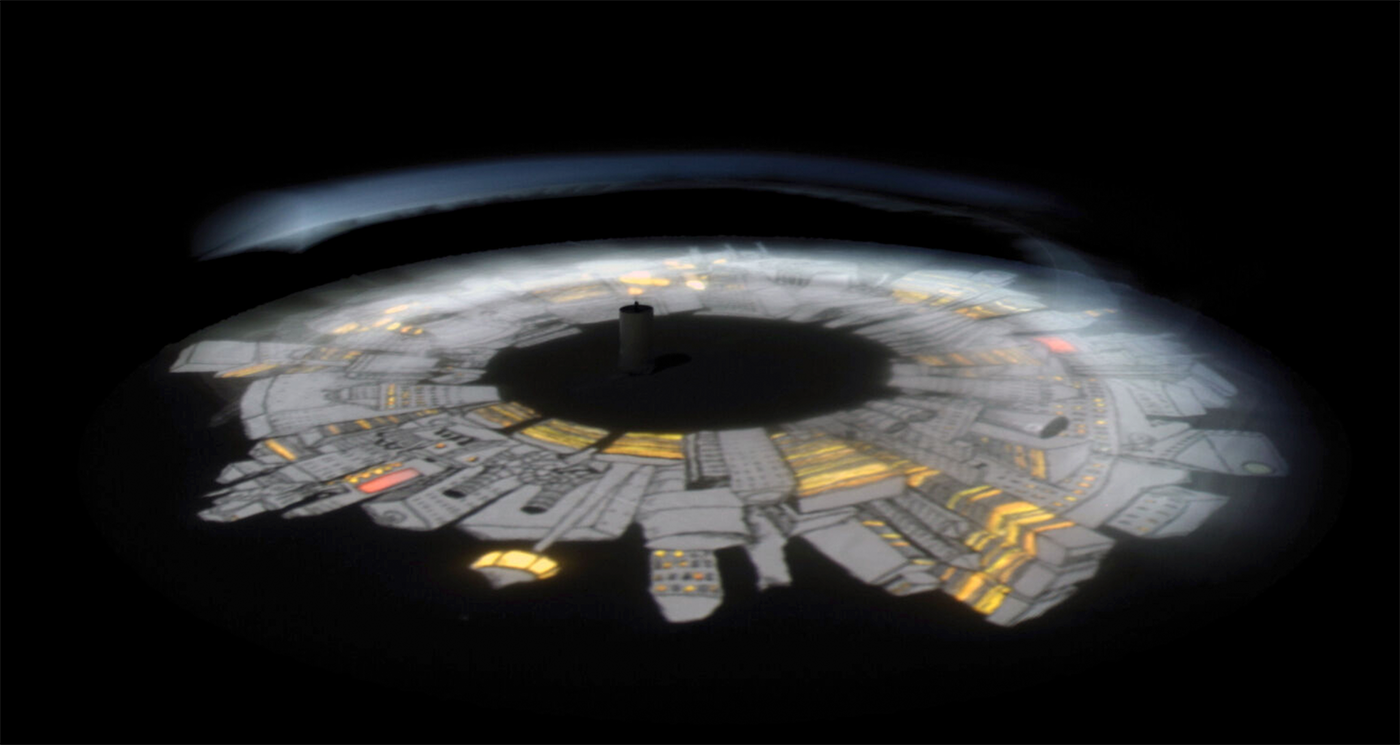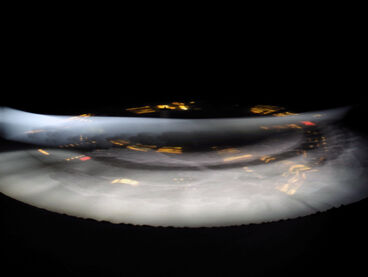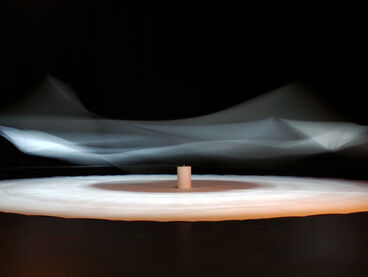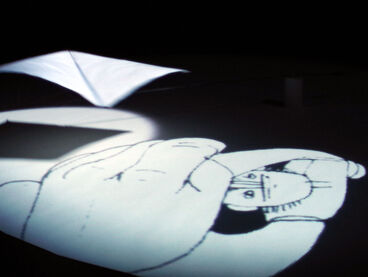MOOZ – audiovisual arts collection
Long Way Home
2013, 2:01 min. (excerpt from the original 5 min. installation), color, sound, Long Way Home
Idea, animation: Katharina Klemm
Idea, sound design: Gerald Schauder
Programming: Luis Négron, Martin Nawrath
Categories: Video, installation, spatial installation, animation
Production: Academy of Media Arts Cologne, Katharina Klemm, Gerald Schauder
Long Way Home
“Where are we going? Home, all the time.” (Novalis: Heinrich von Ofterdingen, Berlin, 1802; trans. Palmer Hilty, 1964)
An (old) man runs and runs and runs, the movement is circular, repetitive, without discernable beginning or end. For this Sisyphean character, the way home is possible in the title only, but there is no chance for arrival. He reaches the paper kite for a moment, and with this, the action of running turns into one of floating and flying over the backdrop of the city. The celestial sounds in the background enhance this moment of lightness and relief, making the scene like a dream.
Long Way Home, a “kinetic video narration,” as Katharina Klemm and Gerald Schauder (sound) describe the story in the opening title, is both an animation and an installation, but the film only reveals the installation aspect later. The paper kite as an object goes around and around over a circular drawing, the projection of which functions as a source of light and as the animation. The work is thus presented filmically as well as spatially.
The movement takes place in the drawing, in the projected image, and in the installation itself. First with the kite alone, then in the skewed perspective of the city, a city skyline in the round, seen as if through a fish-eye-like lens. The city transforms from a faded black-and-white drawing to a color scene lit up in the night that then gradually vanishes as the character floats by, dissolving into the darkening clouds. The animation has several functions; it serves as movement, narrative thread, but also as light source for the installation and the kite as an object. The site and kinetic elements are illuminated. The shadow of the paper kite becomes a part of the animation, adding layers and spatiality to the visuals. The kite reinforces the movement of the protagonist and his indefatigable yet exhausting way home. In the meantime, released from the thread from which everything hangs, the protagonist hangs, floats briefly, to then arrive back down to earth and start running again.
The sound focuses on the noises of the running man and his immediate environment, the city. Thus, it reinforces the act of running, reaching, flying along, letting go, and running again as a part of the cycle, and inscribes the strenuousness of the path he takes and the unreachability of the end point as a fully bodily, auditory experience.
The overlapping of space, kinetics, animation, and sound intensifies involvement in this endeavor, in this pathway without end. As if in a state of delirium, never ending, without escape, freed only for a moment, released, floating, to always land at the beginning again. One moment to the next is blotted out, the time is endless, it is repeating, the way is long. For the viewer the scene is constantly changing: at the beginning the singular sight of both protagonists of the movement, the kite and the running man, full of travail, the man in an unwinnable venture of grasping after the kite. Slowly the view widens to a bird’s-eye perspective of the city (and the installation itself); the animation becomes more detailed until it dissolves again. The circle closes with a return to the beginning of the loop. It keeps going, this breathless straining after the object of desire, the kite, that as an object embodies the moment of flying and simultaneously reaching the sky. One wonders whether the goal of flying was actually achieved through reaching the clouds in the atmosphere or if it could actually continue into space. But here the circle turns back to the earthly; it was a dream. We land on the earth having soared only briefly, to float over the city. Onward home.
The work Long Way Home is perceived differently as an installation in space than it is as a film. The circular structure is directly visible to the viewer. In translating the installation into a film, the observer is at first granted only a selection; the bird’s-eye perspective of the kinetic work implies that the animation is conceived as a purely filmic work. Only through a change in perspective and shift of the camera angle does it become clear that the way home unfolds as a movement in three dimensions. In contrast, this moment of surprise and the disintegration of the scene are missing in the perspective of the viewer in the space. The view comes from the side and gazes from hip height toward the installation and drawing, able to clearly and immediately differentiate the kinetic and animation elements.
An immersion in the installation is intensified with the starting perspective of the film; through the change of perspective the loop becomes more tangible and is experienced in a more concrete way, it dissolves the captivity in the endless looping and provides distance to what is happening. The spatial installation allows both a bird’s-eye view and an all-around perspective from the side. Also, the dimensions of the kite encourage a distanced view of the animated figure.
These different levels of reception show the difficulty, but simultaneously also the possibilities, of a filmic view of an installation. The constraining of the viewer’s perspective, the focus on the soundtrack of the installation, leaving out the actual ambient sound, the camera work around the installation and, in this case, connected with the projection’s circular movement—these are all elements that direct the gaze. The approach to the work results from the perspective of the artist and the installation is a part of this view. From this “kinetic video narration” emerges a filmic work that can stand on its own.
Text - Karin Lingnau












